
Out in the cosmos, there are stars of all colors and sizes. There are red, brown, and white dwarfs, the babies of the bunch. Then you have red giants and blue giants, and even supergiants. But did you know that some of these stars can be broken down further depending on where they are in their lifecycle? One such subtype is a Wolf-Rayet star.

1. It all starts with a massive star.
Stars of different sizes have different phases. A star the size of our Sun is fairly average, burning through its fuel at a steady rate and then becoming a white dwarf upon its death. Some stars, however, are much more massive, have a lot more fuel, and are far more volatile. These stars generally have short but energetic lives and are about 20 times more massive than our Sun. This extra mass causes them to go through a phase not all stars reach, which is how they become Wolf-Rayet stars.
2. When lighter elements are gone, heavier ones become the fuel source.
Wolf-Rayet stars have run out of light elements like hydrogen and helium. These are the elements our Sun is content to burn through, but for Wolf-Rayet new elements must be used and fused. These heavier elements contain more atoms and thus release more energy. All of this energy is sent off as heat and radiation.

3. Heat energy strips the star.
All this energy represents the final death throws of a star. Radiation blows off as million mile per hour wind that rushes out so fast it strips off the outer layers of the star. This process will continue until the star runs out of fuel, at which point it will collapse into a black hole or burst apart into a supernova.


